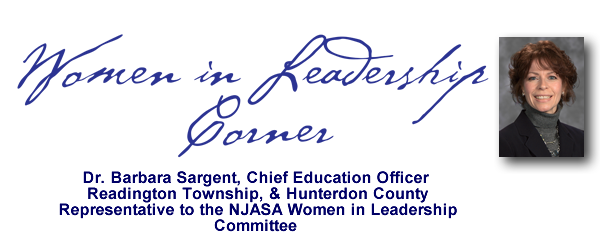- NJASA
- Women in Leadership Corner March 2017

-
Where are the Women?
(Second of a Three-Part Series)
Bear with me while I toss some statistics your way. According to the 2012 U.S. Department of Education Schools and Staff Survey Report, women make up 76% of teachers and 52% of public school principals. Compare that to 23% of public school superintendents who were female during the same year. New Jersey’s numbers are slightly higher, with nearly 30% of public school superintendents identified as female (NJ School Directory 2016). Given the high proportion of female teachers in the state and nation, the percentage of female principals and superintendents continues to be low and results in a lack of significant leadership talent in the chief school administrator position.
What special traits do female school leaders possess?
Several research studies support the understanding that female school principals have followed a very different career path than that of their male counterparts. The majority of female principals have spent more time in the classroom before transitioning to their next position, which more often is that of a guidance counselor or reading specialist. By the time many women enter their first principalship, they have accumulated between 10-15 years of experience with teaching and learning.MEN
WOMEN
- Between 3-5 years of classroom experience;
- Often serve in a coaching capacity;
- Move into a vice-principal position quickly;
- Men typically proceed to a principal’s position within 7 years of entering the profession.
- Between 10-15 years of classroom experience;
- Transition into a variety of positions, including counselor, reading specialist, curriculum coordinator;
- Many women never leave these positions;
- Female principals average 12-15 years of classroom teaching experience.
This difference in experience doesn’t make women better leaders, but additional years of experience with children, curriculum, and teaching certainly yields strong expertise on good instruction. Additionally, women who have worked as school principals have demonstrated the ability to set goals and work with a variety of constituent groups to achieve them. They have also likely established positive relationships with parents, staff, and community members - all important leadership behaviors for superintendents.Why so few female superintendents?
- Many searches traditionally look for high school leadership experience, meaning that the bulk of female leaders with strong elementary leadership experience are often overlooked;
- Lack of female role models in superintendent positions means limited networking opportunities for women interested in upward mobility;
- Unlike a principalship, or even a high-level curriculum position, where it is easy to remain connected with students and teachers, the superintendent’s job tends to pull leaders away from classrooms, with more of the day being spent in high-level planning meetings, board committee meetings, and community events;
- In New Jersey especially, the salary cap has prompted all school principals – not just women – to reconsider whether they would leave a tenured position with consistent opportunities for salary increases for the often uncertain arena of the school superintendency.
So, what’s to be done?
I respectfully submit that the real work should be in encouraging more women to enter the principalship or other high-level supervisory and administrative positions. This is the pool from which superintendent candidates are drawn, and the more women working in this arena, the better their chances for being considered for that top position.Be on the lookout for emerging female leaders in your school community and consider the leadership experiences that will enrich their potential. Encourage your fellow administrators to include teachers on committee work, in presentations to the Board of Education, and in regular conversations about career path, finance, student achievement, and other high-level topics. Women are more apt to have the confidence to pursue leadership positions if they know their supervisors support them and think them capable of such work.
Next Article: Supporting Women in the Job Search and Interview Process


